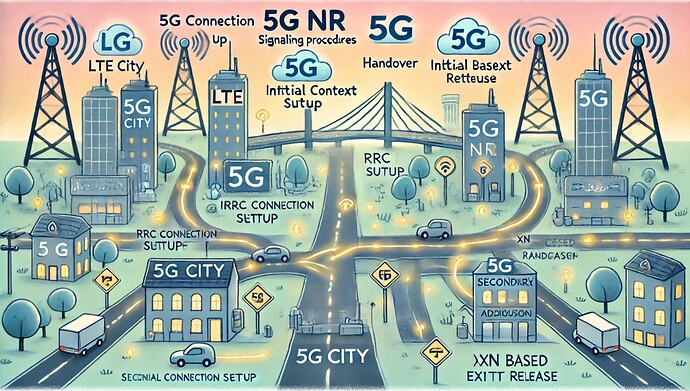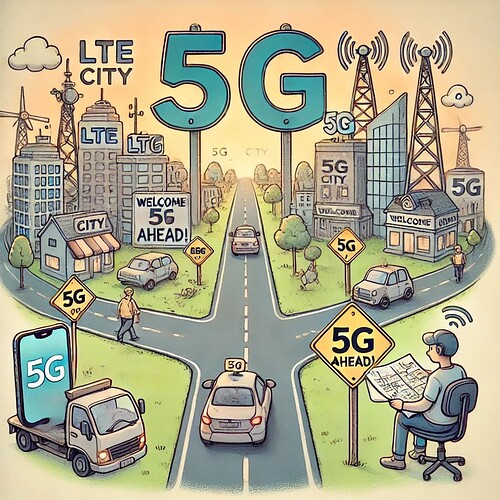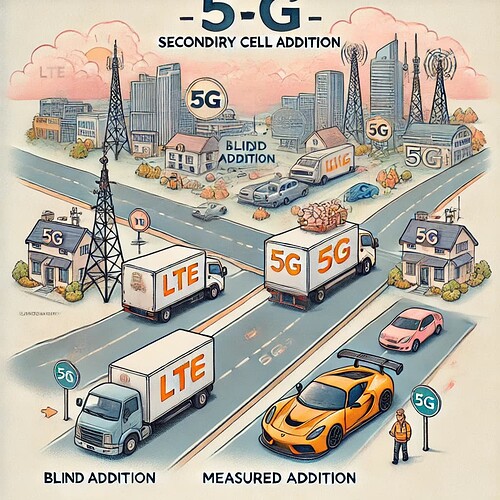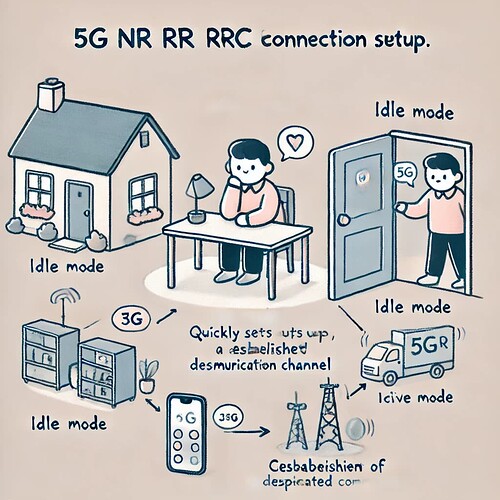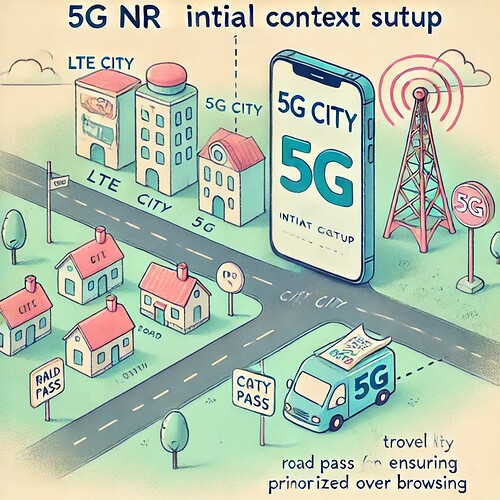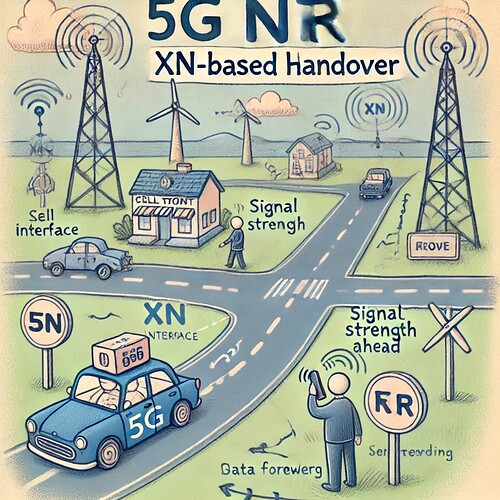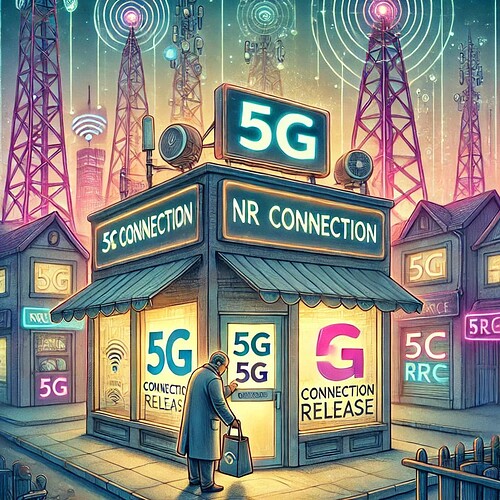This topic presents in a very simplified way all the main concepts that should be understood by those who know 5G NR.
5G NR Signalling Procedures
5G NR Signaling Procedures ensure that your phone stays connected and works seamlessly, even when moving between different areas or switching networks. First, in LTE RRC Idle Mode, the device saves battery by only occasionally checking in with the network, which remains the same in 5G NR. EN-DC Secondary Cell Addition is a new feature where your phone can connect to both 4G and 5G simultaneously for better performance. RRC Connection Setup is the process of starting a connection, which involves setting up communication channels between your phone and the network. This is similar in both LTE and 5G NR. Initial Context Setup configures essential settings like security and service quality to make sure everything runs smoothly, and it’s used in both LTE and 5G NR. XN Based Handover is an improved method in 5G NR that allows for smoother transitions between different cells or networks compared to LTE, which means fewer dropped calls and better connectivity. Finally, RRC Connection Release is how the connection is safely ended, saving battery and network resources, and this process is similar in both LTE and 5G NR. [In a Nutshell: Signaling ensures smooth connections; RRC Idle Mode saves battery; EN-DC combines 4G and 5G for better performance; RRC Setup establishes communication; Initial Setup secures and optimizes connections; XN Handover reduces dropped calls; Connection Release saves resources.]
![]() Imagine LTE City and 5G City as two magical places with super cool transportation systems for phones to travel around. In LTE City, your phone saves energy by only checking the roads once in a while (RRC Idle Mode), which is the same in 5G City. In 5G City, though, phones can also use special roads (EN-DC Secondary Cell Addition) that connect LTE City and 5G City at the same time for faster travel. When your phone wants to start a journey, it sets up a connection (RRC Connection Setup), just like choosing a route in both cities. In both cities, once the journey begins, your phone gets all the necessary instructions (Initial Context Setup) to make sure the trip is safe and smooth. If you need to switch between roads, 5G City has super smart systems (XN Based Handover) that make this switch without any bumps, way better than LTE City. Finally, when the trip ends, your phone safely stops the connection (RRC Connection Release) to save energy and keep everything running smoothly, just like in LTE City. So, 5G City is like an upgraded version of LTE City with even smarter and faster ways to get around! [In a Nutshell: LTE City and 5G City are magical transport systems for phones, with 5G City offering smarter, faster, and smoother journeys.]
Imagine LTE City and 5G City as two magical places with super cool transportation systems for phones to travel around. In LTE City, your phone saves energy by only checking the roads once in a while (RRC Idle Mode), which is the same in 5G City. In 5G City, though, phones can also use special roads (EN-DC Secondary Cell Addition) that connect LTE City and 5G City at the same time for faster travel. When your phone wants to start a journey, it sets up a connection (RRC Connection Setup), just like choosing a route in both cities. In both cities, once the journey begins, your phone gets all the necessary instructions (Initial Context Setup) to make sure the trip is safe and smooth. If you need to switch between roads, 5G City has super smart systems (XN Based Handover) that make this switch without any bumps, way better than LTE City. Finally, when the trip ends, your phone safely stops the connection (RRC Connection Release) to save energy and keep everything running smoothly, just like in LTE City. So, 5G City is like an upgraded version of LTE City with even smarter and faster ways to get around! [In a Nutshell: LTE City and 5G City are magical transport systems for phones, with 5G City offering smarter, faster, and smoother journeys.]
Skip to: Roadmap to 5G NR
- LTE RRC Idle Mode
- EN-DC Secondary Cell Addition
- RRC Connection Setup
- Initial Context Setup
- XN Based Handover
- RRC Connection Release
LTE RRC Idle Mode
LTE RRC Idle Mode helps devices save battery by reducing the need for constant communication with the network, while still staying updated and reachable. It also enables devices to display the “5G” icon and switch between LTE and 5G networks when not actively communicating. LTE sends messages to inform devices about 5G availability, but since LTE often has wider coverage, devices might sometimes show the “5G” icon even where 5G isn’t actually available. To prevent confusion, devices ideally check 5G signal strength first, although this can be complex. Operators and regulators decide when the “5G” icon appears, balancing strict rules for accuracy with flexibility to ensure LTE and 5G work seamlessly and keep users informed. [In a Nutshell: RRC Idle Mode saves battery, manages 5G icons, and ensures LTE and 5G work together efficiently.]
![]() Imagine LTE and 5G are two cities: LTE is a big city with roads everywhere, and 5G is a new, exciting city that’s still growing, with only a few roads for now. Your phone is like a car traveling between these cities. When you’re in the LTE city, there are big signs that say, “5G City is nearby!” to let you know it exists. But sometimes, those signs appear even when the roads to 5G City don’t actually reach you yet. To make sure you don’t drive there for nothing, your car has to check if the roads are good enough to get to 5G City before showing you a “Welcome to 5G” sign. Different traffic managers (like city planners) decide how strict these signs should be – some only put the sign up when you’re fully in 5G City, while others do it as soon as you get close. This keeps your journey smooth and clear! [In a Nutshell: LTE and 5G are cities where signs guide your phone; smart checks ensure a smooth journey to 5G City.]
Imagine LTE and 5G are two cities: LTE is a big city with roads everywhere, and 5G is a new, exciting city that’s still growing, with only a few roads for now. Your phone is like a car traveling between these cities. When you’re in the LTE city, there are big signs that say, “5G City is nearby!” to let you know it exists. But sometimes, those signs appear even when the roads to 5G City don’t actually reach you yet. To make sure you don’t drive there for nothing, your car has to check if the roads are good enough to get to 5G City before showing you a “Welcome to 5G” sign. Different traffic managers (like city planners) decide how strict these signs should be – some only put the sign up when you’re fully in 5G City, while others do it as soon as you get close. This keeps your journey smooth and clear! [In a Nutshell: LTE and 5G are cities where signs guide your phone; smart checks ensure a smooth journey to 5G City.]
- Search Forum
 5G NR LTE RRC Idle Mode
5G NR LTE RRC Idle Mode 
EN-DC Secondary Cell Addition
The EN-DC (E-UTRAN New Radio - Dual Connectivity) Secondary Cell Addition process allows a device connected to LTE (4G) to also use 5G for faster speeds and better performance. First, the device must be connected to the LTE network, which checks the user’s subscription and device capabilities to decide if it can add 5G. This process considers data needs, ensuring LTE handles basic tasks while 5G is used for heavier demands like high-speed data transfer. The addition can be “blind,” where 5G is added automatically, or based on detailed measurements to ensure reliable coverage. Although this process improves network performance, it requires careful coordination between LTE and 5G to avoid delays or disruptions. This dual connectivity enhances voice service performance by utilizing the strengths of both networks. [In a Nutshell: EN-DC enables devices to combine LTE for basics and 5G for high-speed tasks, enhancing performance through dual connectivity.]
![]() EN-DC Secondary Cell Addition is like connecting LTE City and 5G City with extra highways and roads, allowing phones to use the best routes from both cities at the same time for faster travel. In this setup, LTE acts like a reliable delivery truck handling everyday packages, while 5G is a speedy sports car taking care of urgent, high-priority deliveries. First, the truck (LTE) checks if the sports car (5G) is available and whether the customer can use it. If everything checks out, both work together - LTE manages the routine tasks while 5G takes on heavier, time-sensitive demands. Sometimes, the truck sends the sports car automatically without checking the road (blind addition), and other times, it ensures the path is clear (detailed measurements). This teamwork ensures smoother and faster deliveries while leveraging the strengths of both cities and vehicles, even improving voice call performance along the way. [In a Nutshell: EN-DC connects LTE and 5G for faster, more efficient teamwork using the strengths of both networks.]
EN-DC Secondary Cell Addition is like connecting LTE City and 5G City with extra highways and roads, allowing phones to use the best routes from both cities at the same time for faster travel. In this setup, LTE acts like a reliable delivery truck handling everyday packages, while 5G is a speedy sports car taking care of urgent, high-priority deliveries. First, the truck (LTE) checks if the sports car (5G) is available and whether the customer can use it. If everything checks out, both work together - LTE manages the routine tasks while 5G takes on heavier, time-sensitive demands. Sometimes, the truck sends the sports car automatically without checking the road (blind addition), and other times, it ensures the path is clear (detailed measurements). This teamwork ensures smoother and faster deliveries while leveraging the strengths of both cities and vehicles, even improving voice call performance along the way. [In a Nutshell: EN-DC connects LTE and 5G for faster, more efficient teamwork using the strengths of both networks.]
- Search Forum
 5G NR EN-DC Secondary Cell Addition
5G NR EN-DC Secondary Cell Addition 
RRC Connection Setup
The RRC Connection Setup is the process where a phone (or user device) switches from idle mode, where it’s saving power and not actively communicating, to connected mode, where it can send and receive data or notifications like calls or messages. The phone starts this process when a user begins an activity, like opening an app, or when the network needs to deliver something, like a call or text. The process involves a back-and-forth exchange of messages between the phone and the network to establish a dedicated communication channel, ensuring both are ready for data transfer. This “handshake” makes the phone transition smoothly from passive listening to active communication, a key improvement over older technologies like 3G, which were less efficient in handling these transitions. This process is similar in both LTE and 5G NR, involving the exchange of signaling messages to allocate resources and configure the connection for voice services. [In a Nutshell: RRC Connection Setup transitions a phone from idle to active mode, enabling smooth, efficient communication for data and calls.]
![]() RRC Connection Setup: The RRC Connection Setup is like waking up and preparing to take a phone call. Imagine your phone is a person resting in a quiet room (idle mode), just listening for any signs of activity. When someone knocks on the door (a new activity like a message, call, or app request), the person gets up, opens the door, and quickly sets up a desk and chair (the dedicated communication channel) to take notes or have a conversation. This setup requires a quick exchange of confirmations between the person (your phone) and the visitor (the network) to ensure they’re both ready to talk. Once the desk is ready, the conversation can start smoothly. Older systems like 3G were like setting up a big meeting room for every knock, even when unnecessary, while LTE and 5G make the process faster and more efficient. [In a Nutshell: RRC Connection Setup is like preparing quickly for a conversation, ensuring efficient communication between phone and network.]
RRC Connection Setup: The RRC Connection Setup is like waking up and preparing to take a phone call. Imagine your phone is a person resting in a quiet room (idle mode), just listening for any signs of activity. When someone knocks on the door (a new activity like a message, call, or app request), the person gets up, opens the door, and quickly sets up a desk and chair (the dedicated communication channel) to take notes or have a conversation. This setup requires a quick exchange of confirmations between the person (your phone) and the visitor (the network) to ensure they’re both ready to talk. Once the desk is ready, the conversation can start smoothly. Older systems like 3G were like setting up a big meeting room for every knock, even when unnecessary, while LTE and 5G make the process faster and more efficient. [In a Nutshell: RRC Connection Setup is like preparing quickly for a conversation, ensuring efficient communication between phone and network.]
- Search Forum
 5G NR RRC Connection Setup
5G NR RRC Connection Setup 
Initial Context Setup
The Initial Context Setup procedure in LTE ensures that a phone has everything it needs to communicate effectively within the network, including security parameters and quality of service settings. This step is crucial in both LTE and 5G NR, as it authenticates the device and ensures voice and data services meet performance standards. It occurs when the phone connects to the network or moves to a new area, allowing the network to send all the phone’s details, like security keys and service requirements, to the nearest cell tower. The tower then sets up secure and reliable connections. This process also supports multiple services, such as voice and internet, prioritizing critical services like calls over less urgent tasks like browsing. Designed to be fast and flexible, it ensures smooth communication for everything from simple tasks like sending an email to more complex applications, making LTE networks efficient and reliable. [In a Nutshell: Initial Context Setup ensures secure, prioritized, and efficient communication by configuring the phone’s connection to the network.]
![]() Imagine LTE City and 5G City are two amazing places where your phone works. The Initial Context Setup is like your phone getting a special “travel kit” before it can start exploring either city. This kit includes a map (for security), a pass to use roads (for calls and internet), and rules for how to prioritize things - like making sure emergencies (voice calls) are handled before fun stuff (browsing games). When your phone arrives in a new city or moves between them, the network sends all this information to the nearest “city gate” (cell tower), which sets up everything your phone needs to work smoothly and securely. This ensures your phone can do everything it needs, from sending messages to playing videos, without any hiccups. [In a Nutshell: Initial Context Setup is like giving your phone a travel kit for secure, prioritized, and smooth operations in the network.]
Imagine LTE City and 5G City are two amazing places where your phone works. The Initial Context Setup is like your phone getting a special “travel kit” before it can start exploring either city. This kit includes a map (for security), a pass to use roads (for calls and internet), and rules for how to prioritize things - like making sure emergencies (voice calls) are handled before fun stuff (browsing games). When your phone arrives in a new city or moves between them, the network sends all this information to the nearest “city gate” (cell tower), which sets up everything your phone needs to work smoothly and securely. This ensures your phone can do everything it needs, from sending messages to playing videos, without any hiccups. [In a Nutshell: Initial Context Setup is like giving your phone a travel kit for secure, prioritized, and smooth operations in the network.]
- Search Forum
 5G NR Initial Context Setup
5G NR Initial Context Setup 
XN Based Handover
Xn-based handover is an enhanced feature in 5G NR, enabling devices to switch seamlessly between different 5G cells or between 5G and LTE cells without dropping the connection. This improvement over LTE’s handover process ensures uninterrupted and reliable voice service continuity, especially in areas with mixed network coverage. The process works by the network monitoring your phone’s signal strength and quality from nearby towers. If a stronger or more suitable tower is identified, the current tower communicates with the next one using the Xn interface, sharing all necessary details to maintain your connection. Your phone disconnects from the current tower and connects to the new one seamlessly, while data is forwarded between the two towers to ensure no loss. [In a Nutshell: Xn-based handover allows smooth transitions between towers, ensuring uninterrupted connectivity and reliable service in 5G NR.]
![]() Xn-based handover is like taking a road trip where your car (phone) needs to stop at checkpoints (towers) along the way to refuel or get directions. As you approach a checkpoint, the staff (network) checks how much fuel you have (signal strength and quality). If they notice another checkpoint ahead that’s better equipped for your journey, they radio ahead (using the Xn interface) to let the next checkpoint know you’re coming and share all the necessary details about your trip. When you reach the new checkpoint, you’re quickly served, and any supplies or directions you needed are seamlessly handed over, so your journey continues smoothly without interruptions. This efficient coordination ensures you never run out of fuel (lose connection), even when traveling through different regions or between cities (5G and LTE networks). [In a Nutshell: Xn-based handover ensures smooth, uninterrupted travel by coordinating between checkpoints to maintain your journey.]
Xn-based handover is like taking a road trip where your car (phone) needs to stop at checkpoints (towers) along the way to refuel or get directions. As you approach a checkpoint, the staff (network) checks how much fuel you have (signal strength and quality). If they notice another checkpoint ahead that’s better equipped for your journey, they radio ahead (using the Xn interface) to let the next checkpoint know you’re coming and share all the necessary details about your trip. When you reach the new checkpoint, you’re quickly served, and any supplies or directions you needed are seamlessly handed over, so your journey continues smoothly without interruptions. This efficient coordination ensures you never run out of fuel (lose connection), even when traveling through different regions or between cities (5G and LTE networks). [In a Nutshell: Xn-based handover ensures smooth, uninterrupted travel by coordinating between checkpoints to maintain your journey.]
- Search Forum
 5G NR XN Based Handover
5G NR XN Based Handover 
RRC Connection Release
RRC Connection Release is the process of terminating the active connection between the device and the network, returning the device to an idle state. This mechanism, used in LTE and 5G, helps free up network resources when the device (UE) is no longer actively using data or making a call. Triggered by the network when the device becomes inactive, it ensures resource optimization while keeping the device ready to reconnect when needed. The network sends a message instructing the device to transition back to idle mode, where it uses fewer resources but remains connected to monitor for incoming calls or updates. This efficient process minimizes network congestion, conserves resources, and ensures the device stays reachable for future communication. [In a Nutshell: RRC Connection Release ends active connections, freeing resources while keeping devices ready for future communication.]
![]() The RRC Connection Release is like closing a shop in LTE City or 5G City when there are no customers. Imagine a shopkeeper (your phone) who was busy helping customers (sending messages or making calls). When the customers leave, the city (network) tells the shopkeeper it’s time to close the shop (end the connection) and save energy. However, the shopkeeper doesn’t leave completely - he turns off the lights, locks the door (goes idle), and sits near the door, ready to open quickly if a new customer arrives (incoming call or notification). This way, the shop isn’t wasting energy staying open when it’s not needed but is still ready to serve anyone who shows up! [In a Nutshell: RRC Connection Release closes the shop to save energy but keeps it ready for future customers.]
The RRC Connection Release is like closing a shop in LTE City or 5G City when there are no customers. Imagine a shopkeeper (your phone) who was busy helping customers (sending messages or making calls). When the customers leave, the city (network) tells the shopkeeper it’s time to close the shop (end the connection) and save energy. However, the shopkeeper doesn’t leave completely - he turns off the lights, locks the door (goes idle), and sits near the door, ready to open quickly if a new customer arrives (incoming call or notification). This way, the shop isn’t wasting energy staying open when it’s not needed but is still ready to serve anyone who shows up! [In a Nutshell: RRC Connection Release closes the shop to save energy but keeps it ready for future customers.]
- Search Forum
 5G NR RRC Connection Release
5G NR RRC Connection Release 
Quick Summary
- LTE RRC Idle Mode: LTE RRC Idle Mode saves battery, manages the “5G” icon, and ensures seamless LTE and 5G collaboration. (A smartphone pauses (RRC Idle Mode) while driving between LTE City and 5G City, monitoring for smooth transitions.)
- EN-DC Secondary Cell Addition: EN-DC combines LTE for basic tasks and 5G for high-speed demands, enhancing performance through dual connectivity. (EN-DC is like connecting LTE and 5G cities with highways, where trucks (LTE) handle basics and sports cars (5G) handle urgent tasks, ensuring efficient teamwork.)
- RRC Connection Setup: RRC Connection Setup transitions a phone from idle to active mode, enabling smooth and efficient communication for data and calls. (5G NR RRC Connection Setup is like a smartphone responding to a knock, setting up a desk to communicate efficiently, contrasting with 3G’s bulkier process.)
- Initial Context Setup: Initial Context Setup configures a phone’s connection, ensuring secure, prioritized, and efficient communication for voice and data services. (Initial Context Setup is like receiving a welcome package at the city gate (5G network), ensuring secure, prioritized, and seamless navigation for all devices.)
- XN Based Handover: Xn-based handover ensures seamless transitions between towers in 5G NR, maintaining uninterrupted connectivity and reliable service. (5G NR Xn-based handover is like a car smoothly transitioning between checkpoints, guided by traffic controllers (the network) via the Xn interface, ensuring an uninterrupted journey.)
- RRC Connection Release: RRC Connection Release ends active connections, freeing resources while keeping devices ready to reconnect for future communication. (5G NR RRC Connection Release is like a shop temporarily closing in 5G City, conserving resources while staying ready to reopen quickly for future business.)
That’s it. ![]()
-
Continue reading: Roadmap to 5G NR - Radio Network Planning
-
Or back to: Roadmap to 5G NR
